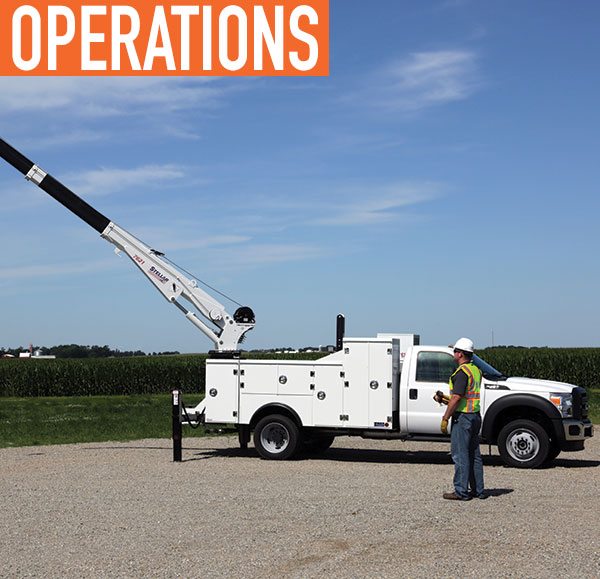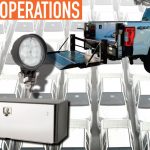A lot goes into spec’ing a work truck and not all of it is easy. Sometimes, it can get downright overwhelming. It’s important to make sure your truck has everything it needs without adding unwanted weight or finding out that you don’t have the appropriate suspension for your needs.
AVOID SPEC’ING MISTAKES
When getting ready to spec a chassis for a work truck, consider these top three mistakes: choosing a chassis with too light of a GVWR, not providing minimum clear back of cab to axle, and using a chassis that is under powered.
If the chassis isn’t equipped with the proper axles and suspension, there is concern of being overweight. When there is not clear back of cab to rear axle, it may take a lot of extra time and money to modify the chassis to get it to work in an upfit, if it will even work at all. The amount of hp has to be taken into account, as well. A truck that is used in a flat city won’t need as much power as one that is used in mountainous terrain.
It’s also important to do your research before spec’ing a work truck’s suspension. One of the top mistakes made in a work truck application is not using a heavy enough suspension. This ties in to the GVWR issue stated earlier. If the suspension is not heavy enough, the truck will be overweight and will lead to premature wear and tear on the chassis, as well as fines from the DOT.
Another mistake that is made is the use of an air bag suspension when a leaf spring suspension is better suited. This is really important to consider when the chassis is used in conjunction with a hooklift or cable hoist, as lifting a load with air in the bags could lead to premature air bag failure. If air bags are being used, an air dump valve is a must.
A third mistake that is made when spec’ing a chassis is not having strong enough frame rails. Most truck equipment manufacturers have minimum frame strength requirements for their respective equipment, which needs to be relayed to the chassis manufacturer at the beginning of the spec’ing process.
CHASSIS SPEC’ING
There are three top tips to spec’ing a chassis for a work truck application:
- Fleet managers must keep an open line of communication with work truck manufacturers and upfitters. Equipment specs need to first be specified with the manufacturer of the equipment and then a chassis spec can be determined. If there are any questions at all, don’t hesitate to ask. In the world of work trucks, there are always questions that have not been answered before. This dialogue helps to create a learning experience for both the fleet manager and work truck manufacturer or truck upfitter.
- Get to know your chassis suppliers. A knowledgeable chassis dealer can be just as helpful in putting together the perfect work truck as the equipment upfitters. They will point out the pros and cons of engine sizes, transmissions, and suspension types.
- Understand your operator’s needs. If your operator spends a lot of time off-road or in muddy environments, don’t hesitate to spend the money up front and go with a four wheel drive chassis with tires that have an aggressive tread. The operator may also have a preference of automatic vs manual transmission. A happy and comfortable operator is a productive operator.
SUSPENSION SPEC’ING
The top three tips to spec a vehicle’s suspension for a work truck application are:
- Pay attention to wheel base, especially on larger trucks. You may have the option of choosing a chassis with a setback front axle, which will shorten your turning radius. However, by moving the axle back, you are going to put more of the final overall weight on that axle, which may lead to overloading of the front suspension. If you have any concern, you should contact your truck equipment manufacturer with the chassis specs and they can do a calculated weight distribution for you, as well as help you find a balance between axle loads and turning radius.
- If the truck is equipped with an air bag suspension, have the chassis manufacturer equip the chassis with dual leveling valves. Work trucks may be loaded heavy to one side, and dual air valves will ensure that the truck remains level when in travel, keeping your driver safe.
- In a work truck application where the chassis uses tandem rear axles, a walking type rear suspension is a must. This will ensure that a heavily loaded truck will keep all eight of the rear tires on the ground at all times, increasing traction and helping the operator to keep the truck from being stuck. If the truck is going to be used off-road often, as in landfills and construction sites, then a locking rear differential is also strongly suggested.
FOR MORE INFORMATION:
Stellar Industries, Inc. was founded in 1990 in Garner, Iowa, and is an employee-owned and operated manufacturer of hydraulic truck mounted equipment. Products include hooklift hoists, cable hoists, container carriers, telescopic cranes, articulating cranes, work truck accessories, and the X-Tra-Lift pickup loading device. Stellar also offers complete mechanic service truck and tire service truck packages. Stellar is a progressive company that focuses on its people, as they are the key to making the products and the company successful. Find out more about Stellar’s products and services, visit www.stellarindustries.com
CONTRIBUTOR
The information in this article was provided by Al Kuhlman. Kuhlman is the assistant product manager at Stellar Industries Inc.
_______________________________________________________________________
MODERN WORKTRUCK SOLUTIONS: MARCH 2017 ISSUE
Did you enjoy this article?
Subscribe to the FREE Digital Edition of Modern WorkTruck Solutions magazine.
![]()




